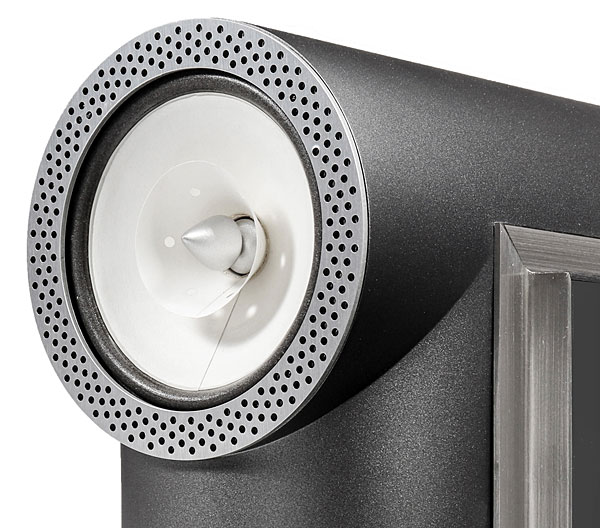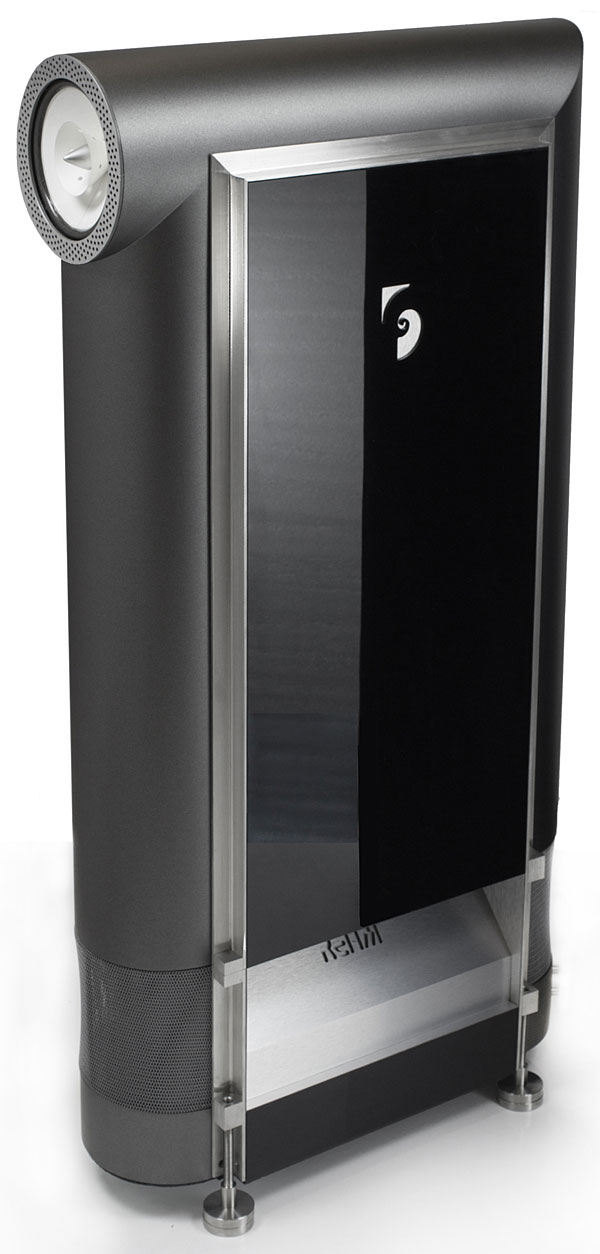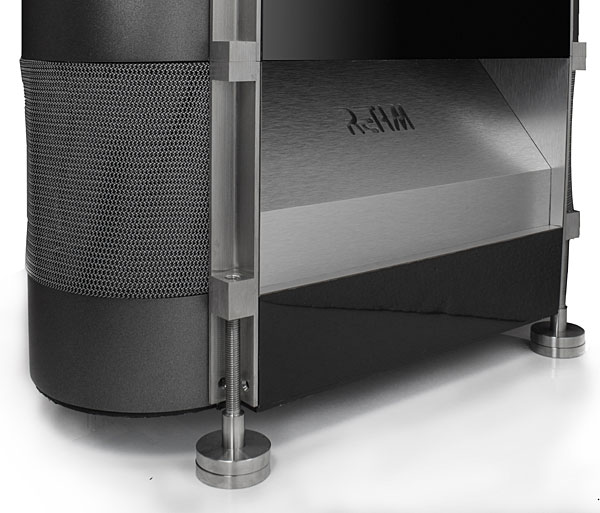| Columns Retired Columns & Blogs |
Wilson Sasha DAW frequency response is somewhat similar to the Rethm Maarga ......... See, manufacturer's comment ..... Sasha DAW also has a 'dip' in the presence region in addition to midrange 'dip' :-) ........
With their bass range dialed in for optimal performance in my room—with the crossovers set at just above the 120Hz detent and the bass volume similarly a bit higher than halfway—the Maargas offered from most recordings sound that was well balanced from top to bottom. Yet I was a little surprised that certain recordings—especially those with a slightly hot or pungent EQ—made the Rethms seem unforgiving. One such was the recording by the Amadeus Quartet of Schubert's D minor quartet, "Death and the Maiden" (LP, Deutsche Grammophone 138 048). In the opening bars, the violins sounded almost strident, so much so that I had to take off that record and put on a different one—the same piece by the Juilliard String Quartet (RCA LSC-2378). Here the Rethms did a better job, presenting the strings with color and realistic, natural-sounding texture, and giving good measure to the room sound during such phrases as the cello's pizzicato notes in the second movement.

The Maargas' bass performance was in many ways very satisfying. On the 1964 recording of Britten's Young Person's Guide to the Orchestra performed by the London Symphony Orchestra and conducted by the composer (Decca SXL 6110), the timpani had superbly clear pitch and decent if not astonishing weight; low-frequency note attacks were a bit soft, but not so much as to spoil the effect. That said, on this LP's flip side—the Britten Serenade, Op.31—the tactile qualities of pizzicato notes in the double basses weren't as physical as I hear from my Altec Flamencos. (But, again, those notes had superb clarity of pitch through the Maargas.)
All in all, it seemed that the Rethm Maargas were exaggerating the flaws of certain imperfectly balanced records; those with slightly prominent upper mids and a relative paucity of upper bass information were less listenable than through my Altec Flamencos (whose own upper mids are not perfect). On the other hand, the Maargas played with exceptionally good temporal cohesion: Music was rhythmically involving, and there were no dragging tempi. Music held together as music and in that sense was compelling.
More listening
And then, after nearly a month with the Maargas, at a time when I was preparing to write a decidedly mixed review, I received another email from Rethm's Jacob George. He wrote: "Last week, while we were doing some listening tests on the new Saadhana, we realised that there was a piece of plywood in the compression chamber that should not have been there, and which was ruining the performance of the speaker in exactly the frequency range we had worked so hard to correct: which was the lower midrange and upper bass region (with effects being heard even higher up thanks to the content of harmonics). And . . . we realised that the three new Maarga pairs that have been shipped to the US also had these pieces of ply. When prototype testing of this new model was done, we had removed this piece of ply to get the response we wanted. But in production, the workshop staff re-inserted this piece by mistake. Big mistake. Unfortunately, the pair that came to you also had this problem." George continued by saying he was on his way to personally fix the three pairs in the US (if I remember correctly, one pair was in Santa Fe, NM, where Stereophile was based for many years: irony of ironies) and wished to arrange a visit here.

Luckily, Stereophile has a policy for that: When a manufacturer alerts us that a product sample is defective in a way that could affect our review findings, we offer the supplier a chance to repair or replace it for another round of listening—with the understanding that we will publish allof our findings in the same review. Jacob George happily agreed, and with the cooperation of David Cope of Old Forge Audio, a Rethm dealer to whom I had handed off the review pair, George made the fix and brought the Maargas back to my house so that I could determine whether the errant plywood had compromised the speakers' initial performance.
I think it had.
I returned to the Amadeus Quartet's recording of Schubert's "Death and the Maiden," which was now far more listenable: It was still obvious that I was listening to a not-terribly-rich-sounding recording being played by a speaker that no one would ever confuse, in terms of richness, with a Sonus Faber Aida, but the sound was now smoother and far better balanced: The upper mids no longer leapt out at me, and I found I could listen through both sides.
Knappertsbusch's Wagner, too, had lost its bite, and Neil Young's Roxy . . . benefitted greatly from the speaker's improved/restored balance: Note attacks now sounded live, but not in-my-face.
Moving on to other material, I thought the "fixed" Maargas sounded especially fine on Delage's beautiful "Quatre Poèmes Hindous" from the album French Songs by Janet Baker and the Melos Ensemble of London (LP, L'Oiseau-Lyre SOL 298). The piano and cello had richness and body, as did the piano—and the lower regions of Baker's voice. Again, my Altecs offered a better sense of scale and a still greater sense of corporeality, but the Maargas excelled at reproducing the air around the instruments and at placing Dame Janet's voice just a few feet away from me. The Rethms' performance on this recording was a high point of their time in my home.

I hate to say anything that might be taken as encouragement for that saddest of all audiophile fetishes, the zeal to listen to a recording of a female singer only for the sake of listening to a female singer (or, if you will, the zeal to listen to a composition for which one otherwise has no particular zeal), but I do love my Bidu Sayão and Rosa Ponselle recordings, especially the latter—hence my ownership of collection Rosa Ponselle as Norma and Other Famous Heroines (Mono LP, RCA Victrola VIC-1507). Here, the Maargas also performed admirably, allowing the period recording to sound appropriately chunky, but never murky, and putting across the instrumental and vocal lines with superb momentum and flow.
Conclusions
By the time of their second departure from my listening room, the Rethm Maargas proved themselves to be worthy candidates in the still-small field of loudspeakers that offer greater than average drivability at less-than-extortionate prices (while also taking up a shade less room than the average horn system).
Even heard at their best, the Maargas fall short of the best in reproducing the full measure of timbral richness and deeply saturated colors locked in the grooves of most Decca SXLs, pre-1970s Rudy Van Gelder recordings, the better LPs from EMI's ASD series, a few choice pop records on the original EMI Harvest label, and suchlike. And one of the speakers that outpace them in that regard, the DeVore Fidelity O/93, sells for considerably less ($8400/pair). But then the O/93s lack the easily tunable bass of the Rethms, not to mention their more distinctive styling.
The Rethm Maargas are musically light on their feet, offer good—and easily adjustable—bass extension, and look like nothing else on the market. (And, as we've seen, their customer support is admirable!) For the low-power amp devotee who wants something out of the ordinary for a less-than-painful price, the Maargas very much deserve an audition.

Wilson Sasha DAW frequency response is somewhat similar to the Rethm Maarga ......... See, manufacturer's comment ..... Sasha DAW also has a 'dip' in the presence region in addition to midrange 'dip' :-) ........

DeVore Gibbon X also has similar FR as the Rethm Maarga, with additional 'dip' in the presence region :-) ......

and ..... they all need amplifiers to drive them too! :-) ........

and ....... they all need speaker wires to connect them to the amplifiers! :-) ........

Rethm Maaga is a little bit different though ....... It has a 'whizzer cone' :-) ........

So is the full ranger 6" as stated in the "description" or 8" as stated in the "specification"?

"I found several high-Q modes in the midrange on all the surfaces (fig.2). Given the Maarga's very high sensitivity, this behavior is unlikely to be audible."- JA
I am curious as to JA's reasoning behind this statement. Sensitivity is an electrical parameter, or how much electrical input is required to get a specific acoustic output.
I do not understand why the sensitivity of the loudspeaker. Would have anything to do with the excitation of resonnant modes in the enclosure. The sidewalls of the speaker should be effectively "blind" to the electrical input, only responding to the mechanical and acoustical output of the speaker cone. As most investigations have shown that it is primarily the acoustic pressure transmitted through the air inside the enclosure, which excite midrange modes, even the fact that the cone may be slightly lower in mass should have little impact.
Would you help me understand your reasoning behind your statement?

I found several high-Q modes in the midrange on all the surfaces (fig.2). Given the Maarga's very high sensitivity, this behavior is unlikely to be audible."I am curious as to JA's reasoning behind this statement.
I measure a loudspeaker enclosure's vibrational behavior with a standard input voltage. This means that the higher the speaker's sensitivity, the greater the output of the drive-units compared with that of the enclosure.
John Atkinson
Technical Editor, Stereophile